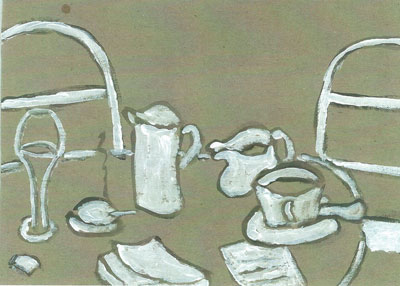Introduction by Alan Catlin
Introduction
Recently, I was going through some old files, revising, discarding, and rediscovering old work, some of which I had totally forgotten about. This particular piece was written over thirty years ago, long before anyone ever thought of doing misfit a magazine of poetry and it seemed like an apt lead in for Victor Smith’s Work in Progress: The Things They Left Behind.
On Hearing of the Death of a Misfit
His name was Looney
and he could do it all on a football field.The first time he touched a ball at OU he ran
62 yards leading the team to a Big Eight
Conference title.
A year later Coach wanted him off the team
for punching out an assistant coach.
He might have won a Heisman if he'd settled down,
after all Terry Baker won in '64 which meant
they weren't as fussy then as they could have been.His Sports Center Eulogy suggested:
"He was blessed with the size of a fullback
and the speed of a half back."
A truly uncommon trait in 1963
the year the Giants made him their draft pick #1.Not only would he not tape his ankles,
he told a flabbergasted Coach Sherman:
"I knew more about my ankles than you do."
he refused to learn the plays.His next coach wouldn't let him display
his magnificent punting skills as he was afraid
to put Looney in the game to punt because,
"You never knew what he would do with the ball."After football, he would go AWOL in the Nam,
take up drugs, become a vegetarian and keep
an elephant as a pet before becoming a recluse
for good.Joe Don died young at 45, dumping his bike
on a highway near Big Bend National Park in Texas.
He will be missed.Joe Don was the first in an informal series of poems about misfit athletes who had at least, one great moment in the sun. Or could have, if their lives hadn’t gotten in the way. Besides Joe Don there was Super John Williamson, a playground phenom who parlayed near-legendary playground hoop skills into a successful college career and stardom in the old ABA. In the era before the Jordan’s and the James’s, he sure could play but he blew it all, was labeled an overweight malcontent and was washed up by 30. Then there was Doc Ellis who pitched a perfect game after “accidently” taking a hit of acid on what was supposed to be an off day for the pitcher. He later would say: despite all the visions he was having he never felt more in the zone (as the poem I wrote about him was called) on that day. The ball seemed to float through the hallucinations and find their mark in the catcher’s enormous glove. He would never again approach such greatest in a star-crossed career. More recently, there was Bob Welch, who claimed that the greatest thrill he had in the early part of his career, sober, was striking out Reggie Jackson in the World Series. He went on to say: I was like 23 and I wasn’t drinking before games, yet, then. It was the World Series after all, but that’s wouldn’t have stopped me not too far down the road… Later on, sober, he won the Cy Young Award winning 27 games for the A’s after the Dodgers finally gave up on the talented but screwed up young man.
Athletes seem perfect misfits, as they have a special talent no one else has that everyone wishes they did. Misfit athletes are probably more unusual than other success stories played out in the public eye, as the rules that govern progress through the ranks of sport are rigid, practically inflexible. These strictures channel the athlete in proscribed ways. Those who make it in sheer talent alone, despite some glaring personal defect, are the true misfits. Alas, though, these days, athletes are often easily divided into two distinct categories: gangbangers and athletes for Christ. At least, in football and basketball. A screwed up gangbanger seems to be well, a screwed up gangbanger. It is difficult to summon much sympathy for say, accessory to murder Ray Lewis, accused multiple murder Aaron Hernandez, dead druggie Sean Taylor and so on and so forth. The steroid abuse victims, well, they seem to be pretty much like losers in a deal with the devil. You get what you pay for. Where have you gone Alex Rodriguez? There is no second verse or answer to that question because, frankly, who cares?
The high profile losers, well, what to they leave behind? Lost promise but the-could-have-beens, the maybes, the almosts, they seem more like us, less like created by the media, television reality stars. After all what is television reality but an insular, self generating, endless hall of mirrors and we know where that leads. Which brings us to Victor’s What They Left Behind, a true work in progress, gleaned from the obituary pages of newspapers. Like Feneon’s, Novels in Three Lines, Victor has condensed an already simple summary to its essence, in a way that is both darkly humorous and oddly revealing. Are we, ultimately, who we say we are?
